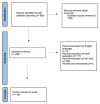Cervical Spinal Epidural Abscess: Diagnosis, Treatment, and Outcomes: A Case Series and a Literature Review
- PMID: 37445544
- PMCID: PMC10342465
- DOI: 10.3390/jcm12134509
Cervical Spinal Epidural Abscess: Diagnosis, Treatment, and Outcomes: A Case Series and a Literature Review
Abstract
Although recent diagnostic and management methods have improved the prognosis of cervical epidural abscesses, morbidity and mortality remain significant. The purpose of our study is to define the clinical presentation of cervical spinal epidural abscess, to determine the early clinical outcome of surgical treatment, and to identify the most effective diagnostic and treatment approaches. Additionally, we analyzed studies regarding cervical epidural abscesses and performed a review of the literature. In this study, four patients with spinal epidural abscess were included. There were three men and one woman with a mean age of 53 years. Three patients presented with motor deficits, and one patient was diagnosed incidentally through spinal imaging. All the patients had fever, and blood cultures were positive. Staphylococcus aureus was the most common organism cultured from abscesses. All patients underwent a surgical procedure, and three patients recovered their normal neurological functions, but one remained with mild neurological disability that was resolved two years postoperatively. The mean follow-up period was 12 months, and no deaths occurred in this series. Furthermore, we identified 85 studies in the literature review and extracted data regarding the diagnosis and management of these patients. The timely detection and effective management of this condition are essential for minimizing its associated morbidity and mortality.
Keywords: cervical spinal epidural abscess; outcome; surgery; treatment.
Conflict of interest statement
The authors declare no conflict of interest.
Figures




Similar articles
-
Spinal epidural abscess: clinical presentation, management, and outcome.Surg Neurol. 2005 Apr;63(4):364-71; discussion 371. doi: 10.1016/j.surneu.2004.08.081. Surg Neurol. 2005. PMID: 15808726
-
Timing in the surgical evacuation of spinal epidural abscesses.Neurosurg Focus. 2014 Aug;37(2):E1. doi: 10.3171/2014.6.FOCUS14120. Neurosurg Focus. 2014. PMID: 25081958
-
Spinal Epidural Abscess: A Single-Center Retrospective Review of Incidence, Risk Factors, and Management at a Community Hospital.Cureus. 2025 Apr 21;17(4):e82727. doi: 10.7759/cureus.82727. eCollection 2025 Apr. Cureus. 2025. PMID: 40400859 Free PMC article.
-
Holospinal epidural abscesses - Institutional experience.J Clin Neurosci. 2018 Feb;48:18-27. doi: 10.1016/j.jocn.2017.10.057. Epub 2017 Nov 4. J Clin Neurosci. 2018. PMID: 29113855 Review.
-
An institutional series and contemporary review of bacterial spinal epidural abscess: current status and future directions.Neurosurg Focus. 2014 Aug;37(2):E9. doi: 10.3171/2014.6.FOCUS14146. Neurosurg Focus. 2014. PMID: 25081969 Review.
Cited by
-
Cervical Spinal Epidural Abscess From Haemophilus influenzae in an Adult: A Case Report.Cureus. 2024 Dec 2;16(12):e74946. doi: 10.7759/cureus.74946. eCollection 2024 Dec. Cureus. 2024. PMID: 39744277 Free PMC article.
-
Research hotspots and development trends of Brucellar spondylitis in the past 30 years: a bibliometric analysis.Front Microbiol. 2025 Feb 19;16:1541792. doi: 10.3389/fmicb.2025.1541792. eCollection 2025. Front Microbiol. 2025. PMID: 40046306 Free PMC article.
-
A rare case of Streptobacillus moniliformis epidural abscess requiring neurosurgical decompression.Surg Neurol Int. 2024 Jul 26;15:263. doi: 10.25259/SNI_402_2024. eCollection 2024. Surg Neurol Int. 2024. PMID: 39108398 Free PMC article.
-
Upper cervical epidural abscess with emphasis on diabetes as a risk factor: a case report.BMC Neurol. 2024 Sep 28;24(1):361. doi: 10.1186/s12883-024-03831-9. BMC Neurol. 2024. PMID: 39342124 Free PMC article.
References
LinkOut - more resources
Full Text Sources

